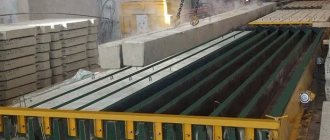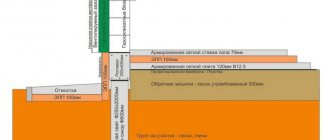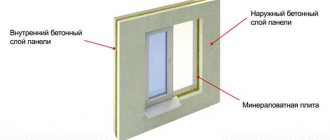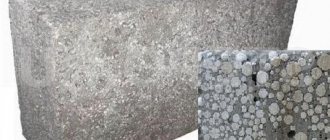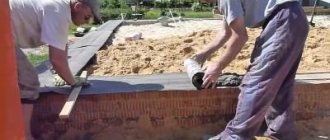Driven pile foundation is a type of foundation in which pile pillars are driven in without first removing soil for installation. The classic installation method is hammering piles. For this purpose, special piling equipment is used - hydraulic, steam-air or diesel hammers. In some cases, other methods are used to drive piles. These include installation by vibration and indentation. The ground part of the piles is fastened with a grillage.
How to calculate the basis?
The calculation of a pile-driven foundation is made based on the total load and bearing capacity of the pile.
The load is determined by summing up the weight of the house, roofing system, snow and wind loads, property and other factors that increase the pressure on the supports.
The load-bearing capacity of a pile is the sum of the soil resistance at the bottom of the shaft and along the side walls.
The total weight of the house is divided by the load-bearing capacity of one support - the number of piles required to form a pile field for a given building is obtained.
IMPORTANT!
Foundation calculations are a complex engineering task that must be performed by experienced, trained people. Self-calculation can cause deformation or destruction of the house, so you should not take risks. At a minimum, you can use an online calculator, but it will also require geological exploration data for the site.
Application area
Pile-driven foundations are typical for heavy and massive houses made of brick or concrete.
The high load-bearing capacity of the supporting structure allows the construction of tall multi-storey buildings and structures of complex configuration.
In private housing construction, they are used to support two- and three-story brick houses, mansions or castles, which have a large weight and uneven distribution of the load on the support.
Advantages and disadvantages
Before installing the structure, you should familiarize yourself with the positive and negative sides of the issue and study important operational characteristics.
The advantages of a foundation made of reinforced concrete piles include:
- Positive results of construction in problem areas (except for rocky soil)
- Rapidity. The structure can be installed within 24 hours, while the traditional method of constructing a foundation requires at least 7 days. After this, the construction of load-bearing structures can be carried out immediately (the monolithic foundation allows work to continue only after 3-4 weeks).
- Reducing construction and excavation materials to a minimum.
- All-season. It is possible to form a foundation on driven reinforced concrete piles at any time of the year, regardless of climate and weather.
- Duration of use. Reinforced concrete piles for the foundation are very wear-resistant and can withstand any weather disasters. The term of their suitability can be about one and a half hundred years.
- Strength. Reinforced concrete foundation piles, in the construction of which metal rods are used, are characterized by the ability to carry multidirectional loads, which is a necessary quality in unstable areas.
The foundation on driven reinforced concrete piles has only a few disadvantages.
- Possibility of subsidence or curvature of the foundation. There is always the possibility of unreliable characterization of deep soil, since it is not possible to consider a multi-meter layer.
- Mandatory use of expensive specialized equipment for installing piles.
- The lack of a basement and basement is a real inconvenience that people who decide to build a foundation on reinforced concrete piles will have to face.
Advantages and disadvantages
The advantages of driven piles include:
- Possibility of use on all types of soils, excluding rocky ones.
- The supports are able to withstand significant loads .
- The service life of the piles exceeds the period of operation of the house.
- The production technology allows the trunks to withstand not only vertical, but also horizontal impacts of moving layers of soil. This is especially important at great diving depths .
- Installing the piles takes a little time.
- The amount of excavation or building material used is small .
- Ability to carry out work throughout the year in any conditions.
Disadvantages should be considered:
- There is no possibility of creating basements, ground floors and other recessed rooms.
- The need to use special equipment .
- Significant inconvenience during diving for residents of nearby houses.
- There is a danger of disrupting the operation of the foundation of neighboring buildings if construction is too close.
IMPORTANT!
Difficulties with arranging basements are largely a consequence of the unpreparedness of the soil, and not the type of foundation. Even in the absence of obstacles in the form of supports, the construction of underground premises causes insurmountable difficulties due to high heaving, water content or instability of the soil .
Kinds
The classification of supports of this type can be carried out on the basis of several criteria. In general, all reinforced concrete piles are divided into 2 types - frames poured with concrete directly on the construction site and analogues manufactured in a factory.
Their design – installation technology – in some way depends on the type of piles. Thus, piles that are poured directly after installation into the ground can be installed by driving them with hydraulic hammers, using the vibration driving method, or using pressing technology under the influence of static (constant) pressure.
Depending on the design features, reinforced concrete piles are divided into several types.
Monolithic
They are a solid support with a rectangular or square cross-section, although piles with a round, trapezoidal or T-section with a size of 20-40 mm are possible. The lower end is pear-shaped and can be sharp or blunt. Such supports are not hollow, so there is no need to make holes in the ground to immerse them. The technology of hammering or vibration pressing into the soil is used. They are widely used in civil engineering and are also in demand in the construction of a private house (wooden, block, frame).
Hollow (shell)
It has the form of a shell, for immersion into the ground of which a well is first prepared. The support can be round or square, but the latter still has a circular cross-section. Hollow supports, in turn, are divided into solid and composite (consisting of several elements that are assembled immediately before immersion).
Printed
But it is also mounted by immersing it in a pre-prepared recess.
Depending on the type of reinforcement, reinforced concrete piles are of the following types:
- supports with non-tensioned longitudinal reinforcement with transverse reinforcement;
- supports with prestressed longitudinal reinforcement with or without transverse reinforcement.
If we talk about the cross-sectional shape of piles, they can be round (hollow or solid), square, square with a round cavity, and rectangular. It is unacceptable to place supports with a square cross-section in permafrost soil. Even with a small amount of thawing, the pile will tilt and the building will skew. In regions with increased seismic activity, structures with a circular cross-section should be used.
There are one-piece and prefabricated structures. The latter consist of several segments, making it possible to increase the height of the product. The segments are fixed by welding or by bolting.
How to make piles for a foundation
Poured piles
It’s easy to make a foundation made of reinforced concrete piles yourself
It is only important to maintain basic calculations:
- trunk sizes;
- gaps between trunks;
- reinforcement parameters;
- brand of concrete;
- laying frequency.
Concrete mix
Preparation of concrete mixture
Pile foundations are often installed in aggressive environments. For this reason, they need durable, chemical-resistant concrete. This property of concrete affects the durability of the pile.
You should consult with specialists about the brand of concrete, who, after studying the soil, will recommend appropriate additives to increase stability.
Possible concrete composition:
- cement grade 7001 parts;
- sand 1.5 hours;
- crushed stone 2.5 hours;
- water 0.5 tsp.
Preparing the site for the foundation
Before starting the installation of piles, prepare the site:
- remove tree roots and topsoil;
- mark the location of the foundation using cords;
- determine the levels of trunks above the surface;
- mark the axes of the piles.
Concreting and reinforcement of piles
After preparing the holes for the piles, “pipes” are rolled out of roofing material, which should correspond to the wells in coverage, and the length is 20-30 cm greater than their depth.
The “pipe” at the top needs to be made stronger, from 2-3 layers of roofing felt, and tied together with strong wire. This end will be the top formwork. Then the “pipe” is carefully driven into the well.
If there is a little water at the bottom, it's okay. But when water fills a quarter of the well, it needs to be pumped out.
Formwork
Pile formwork
Concrete hardening occurs within the first 24 hours from the moment the mixture is prepared.
And in order for the strength to be maximum, it is extremely important to preserve the “cement laitance” in the concrete mass. It should not flow into the ground, because then the specified strength of concrete will not be achieved
If the ground surface freezes, heaving forces will affect the rough surface of the pile more strongly if it was formed without a “pipe”.
When the wells are prepared, a frame made of reinforcement will be needed. For this purpose, you can take 3 reinforcement rods of six millimeter diameter for each pile shaft. They are fastened with transverse bars at intervals of 50-60 cm.
Vertical rods are installed above the piles below the height of the grillage by 2-3 cm.
Grillage arrangement
Installation of a bored pile foundation with a recessed grillage
To install a grillage for a light home, it is recommended to observe the following parameters:
- height – from 30 cm;
- the width is equal to the width of the base, and if there is none, the width is equal to the thickness of the walls of the 1st floor, but not less than 40 cm.
Cutting the grillage with pipes is unacceptable. The deviation of the pile from the vertical is determined by a plumb line. It should not be more than 5 cm.
When assembling the grillage, you need to carefully secure the elements to the pile heads. If the grillage beam is replaced with load-bearing reinforced concrete lintels, they are secured to each other by welding with reinforcing bars.
After assembling the grillage, all seams and joints are filled with cement mortar or concrete.
Installation diagram
Procedure:
- Preparatory work . Equipment is being relocated, piles are being transported and stored. The site is being cleaned and leveled, and the pile field is marked.
- Test piles are being driven . This is necessary to determine the conditions and parameters of supports in practice. For private housing construction, this point is often skipped, although it is very important and allows you to avoid mistakes.
- The piles are being driven.
There are several driving schemes, due to the need for equipment to approach the installation point.
Illiterate distribution may make it impossible to install any supports due to the interference created by already submerged trunks.
The following schemes are used:
- Consistent.
- Sectional.
- Spiral.
The selection of the most suitable scheme is made by specialist pile drivers who have sufficient experience in such matters .
The final stage is the creation of a grillage. After driving and curing the pile, which lasts up to 20 days, the trunks are trimmed with a special tool.
It removes the concrete, leaving the reinforcement intact. It is connected to the armored belt of the grillage, which is cast in a specially created formwork .
The whole range of work is carried out - creating formwork, waterproofing, installing reinforcement cage and pouring concrete. Only durable grades are used, from M200 and above. The formwork is removed 10 days after pouring, the curing period lasts a total of 28 days.
After the material has been cured to gain structural strength, the visible part of the foundation is waterproofed , then construction can continue.
Application of grillage
A grillage is an element of the foundation structure that connects piles into a solid structure and provides support for load-bearing components. According to some reviews, you can do without it. However, the foundation on driven reinforced concrete supports with a grillage is more reliable and stable than in a situation without it.
According to the manufacturing method, reinforced concrete and metal are distinguished.
To obtain the first, the solution is poured into a pre-prepared formwork with a built-in and fixed reinforcement frame.
To make a metal grillage, rolled metal products such as I-beams, rails, and channels are used. They are placed on supports driven in level and welded to iron rods that are visible outside the supports. The components are fastened together by welding or bolts.
There are three types of grillage:
- hanging. It is located at a considerable distance from the soil; there is an uninsulated hollow space under the floor. It is used in the construction of temporary buildings: baths, attics, small country houses. In this case, the use of mini reinforced concrete piles is allowed.
- shallow. It sinks to a small depth into the ground. They cannot act as a support, they are used as a means of protecting the space under the floor, the building from unfavorable climatic conditions, changes in the movement of air masses;
- recessed To create it, dig a trench similar to a strip base. It provides extra support for the building, strengthens the foundation on piles, and is ideal for the construction of a solid year-round building.
Types of piles
When constructing premises with a small number of floors or frame houses, it is possible to use these types of supports.
- Reinforced concrete. The most widely used. They are available in any landscape; a large number of companies specialize in both the production and installation of piles. The operational period ranges from 50 to 150 years. There may be differences based on certain criteria:
- supports with prestressed and non-prestressed metal rods;
- types of sections: round, square, T-shaped and hollow;
- shape: prismatic and cylindrical;
- structure: solid and subject to assembly;
- base: expanded, bound or hollow.
- Wooden. They are very popular in the construction of log houses made of wood and frame structures on a wooden base. Their degree of reliability is lower than that of the previous ones, so they can only be created from certain types of wood. Recommended for use on heaving soils. The above type of supports are usually made from cedar, oak, larch, and other hardwoods. Wood supports with a diameter of 20-40 cm and a length of three to 8 meters are used. When used on hard ground, it is necessary to use a shoe - a steel cap with strapping, which is attached to the bottom of the sharpened end of the pile. Weather conditions, climatic changes, and soil characteristics have a huge impact on the performance characteristics of wooden supports. If all rules are followed, the service life is at least 50 years.
- Steel. There is a wide range of materials for the production of this type of piles: rails, channels, pipes, etc. They are used infrequently, as a rule, for temporary buildings or utility structures. The approximate period of operation is 40 – 60 years.
Our advantages
More than 30 years on the market
Production is based on scientific developments of the best Russian metallurgical and construction research institutes
Only high-quality steel (service life up to 120 years), not afraid of corrosion
Wide range for different tasks: For any soil (on land and on water), for any low-rise construction
Suitable for all-season installation (Our piles keep the foundation from frost heaving)
Hundreds of objects in Moscow, the Moscow region and other regions of Russia have already been standing on our stilts for decades!
Easy to calculate and construct
Limitations in the use of pile foundations
Locality data collection process
This type of foundation also has disadvantages, or rather restrictions, that prevent their use.
Reinforced concrete foundations should not be used in horizontally unstable soils, because the building will not be resistant to overturning.
When constructing such a foundation, problems arise with the base.
You have to fill the space between the piles, as in a columnar foundation.
This requires additional costs.
The video demonstrates the driving of reinforced concrete piles IZH-3-38-S1 (S2) S-08 without formwork molding
Peculiarities
Reinforced concrete piles (RC) are a reinforcement frame that is filled with concrete mortar. The length of the finished product can range from 3 to 12 m.
Reinforced concrete piles are used to organize the foundation using driving technology. Their use allows you to strengthen the base and reach durable layers of soil.
Visually, they represent bases with a round (hollow or filled) or square cross-section. They differ in diameter and height, which determines the load-bearing capacity and scope of application. In addition, strength indicators depend on the type of concrete used. The higher it is, the more reliable the elements.
To create reinforced concrete piles, cement is used, the grade strength of which is at least M100. Not only the compressive strength of the pile, but also its frost resistance and moisture resistance depends on the performance characteristics of concrete. The latest parameters for concrete grade M100 are F 50 (that is, the structure can withstand up to 50 freezing/thawing cycles) and W2 (water column pressure) - 2 MPa. The weight of the support is determined by its dimensions and also depends on the density of the type of concrete used.
Typically, denser grades of concrete M-250, M-300, M-400 are used. The frost resistance of such products reaches 150 cycles, and the water resistance coefficient is at least 6.
Thanks to the increased resistance to the possibility of driving piles to great depths, their use becomes possible on moving soils (including in zones of increased seismic activity), on clayey, heaving and soft soils, in water-saturated and swampy soils.
Reinforced concrete piles can be used not only as the base of a foundation, but also to prevent pit collapse, strengthen the soil and an existing pile foundation. To do this, reinforced concrete supports are immersed at a short distance from the existing structures, performing the function of a second pile. In addition, with additional strengthening of the foundation, the type of supports in question can be moved beyond the existing foundation and connected to it through beams.
Price of reinforced concrete driven piles with installation
| Driven reinforced concrete piles 150x150x3000 | ||||
| Number of pieces | 0-50 km from MKAD | 51-100 km from MKAD | 101-150 km from MKAD | from 151 km from MKAD |
| 1 — 19 | individual calculation | individual calculation | individual calculation | individual calculation |
| from 20 | from 3,500 ₽ | from 3,700 ₽ | from 4,000 ₽ | individual calculation |
| Driven reinforced concrete piles 150x150x4000 | ||||
| Number of pieces | 0-50 km from MKAD | 51-100 km from MKAD | 101-150 km from MKAD | from 151 km from MKAD |
| 1 — 19 | individual calculation | individual calculation | individual calculation | individual calculation |
| from 20 | from 4,200 ₽ | from 4,400 ₽ | from 4,800 ₽ | individual calculation |
| Accessories for reinforced concrete piles 150*150 | ||||
| plate (200/250) mm | economy head (200/250) mm | head (200/250) mm | ||
| 250 rub/400 rub | 410 RUR/570 RUR | 760 RUR/850 RUR | ||
| Driven reinforced concrete piles 200x200x3000 | ||||
| Number of pieces | 0-50 km from MKAD | 51-100 km from MKAD | 101-150 km from MKAD | from 151 km from MKAD |
| 1 — 19 | individual calculation | individual calculation | individual calculation | individual calculation |
| from 20 | from 5,300 ₽ | from 5,600 ₽ | from 5,900 ₽ | individual calculation |
| Driven reinforced concrete piles 200x200x4000 | ||||
| Number of pieces | 0-50 km from MKAD | 51-100 km from MKAD | 101-150 km from MKAD | from 151 km from MKAD |
| 1 — 19 | individual calculation | individual calculation | individual calculation | individual calculation |
| from 20 | from 6,700 ₽ | from 7,000 ₽ | from 7,350 ₽ | individual calculation |
| Accessories for reinforced concrete piles 200*200 | ||||
| plate (250/300) mm | economy head (250/300) mm | head (250/300) mm | ||
| 400 rub/500 rub | 510 RUR/710 RUR | 1400 rub/1700 rub | ||
Additional service Fluffing of reinforced concrete piles 450 RUR/piece
Types of foundations built on reinforced concrete rods
Foundation on reinforced concrete piles
The type of foundation chosen depends not only on the quality and characteristics of the soil on which the building will be built. I choose the type of foundation depending on the weight of the building and its configuration:
- The foundation can rest on single rods. This is possible when constructing buildings with columns.
- The strip foundation requires the installation of piles along the entire perimeter of the pit.
- Cluster - a depression in the ground in one place of several rods. This design is designed for the construction of buildings requiring reinforcement of support under individual elements.
- “Field” is a foundation, the creation of which is necessary during the construction of objects with increased load. In this option, reinforced concrete piles are located both around the perimeter and throughout the entire area of the pit.
Such structures can be recessed, located on the ground surface, or elevated on it.
The durability of the rods directly depends on the quality of the concrete used to create them. Therefore, the ideal option is industrial concrete, the preparation of which is carried out taking into account the most important indicators such as compressive strength, maximum water pressure, and frost resistance.
Stages of construction of a driven pile foundation
Before proceeding with the installation of the foundation, it is necessary to calculate the necessary parameters and draw up a design for the building and the foundation itself, taking into account the weight, layout and other features of the future construction.
Several factors are taken into account during the design.
Soil features.
- depth of groundwater;
- aggressiveness of the environment;
- soil type;
- soil flooding level, etc.
The weight that the foundation will have to support.
- the mass of the structure itself;
- snow load;
- operational load (furniture, people, etc.);
- weight of the roof, attic floor, etc.
Location of piles . The piles are located:
- at each corner along the outer perimeter;
- at the intersections of internal walls and the joints of external and internal walls;
- additional piles are located around the perimeter of the building and interior spaces, the distance between the piles should be no more than 3 meters .
Pile location project.
Technical characteristics of reinforced concrete piles
Reinforced concrete piles of various sizes
Most of the parameters of pile shafts are determined by the grade of concrete used in their manufacture.
For example, the grade of concrete characterizes the strength of the trunk. The concrete grade numbers indicate the ultimate compressive strength.
Concrete B7.5 and higher class is used in the production of reinforced concrete piles. The lowest compressive strength is determined by this type of concrete.
Indicators of frost resistance and moisture strength of piles are determined using the same method. They appear on the identification plate after the letters “F” and “W”. For example, for concrete grade B7.5, these parameters are equal to more than 50 cyclic freezing/thawing (F50) and a pressure limit of 2 MPa of water (W2).
The mass of reinforced concrete trunks is determined primarily by their volumes. And the larger they are, the greater the weight indicators.
The positive qualities of reinforced concrete piles of any type include:
- service life (If the construction of the foundation was carried out without violating the technology, the piles will last more than 100 years without repair);
- high strength (Reinforced concrete piles can withstand the weight of even multi-story panel buildings);
- stability (the trunk is driven to a depth, which allows it to rest on the ground with great bearing capacity);
- the possibility of using supports for construction on difficult terrain (The piled part of the foundation base can be constructed from supports of different lengths.)
Pile field for the foundation for the construction of a two-story brick house
Foundations on reinforced concrete piles are made in areas where the soil is problematic and a building needs to be built. In areas with such soil, only reinforced concrete piles will ensure the stability of the building by transferring the load to stable layers.
A reinforced concrete pile foundation for a block building has many advantages over other types of foundations.
If we compare the construction of a columnar foundation with others, then the construction of such a foundation for a house made of blocks is much more technologically advanced.
A pile foundation involves drilling wells of a given size, installing reinforcing bars in them, and filling them with concrete.
The big advantage of this method is the ability to drill wells with a hand drill.
Adviсe
Piles are produced by large factories or production workshops at construction companies. As a rule, the products of the former have a lower cost, but factories prefer to cooperate with wholesale buyers.
If you need a limited number of supports, it is better to contact the workshop of a reputable construction company. As a rule, you can order piles here at least individually, but their cost will be higher. This is due to the fact that small companies cannot increase their power, so they increase their own income by increasing the price.
It is better to choose domestically produced piles, since they are manufactured in compliance with GOST requirements.
Typically, the price of a pile depends on its length and cross-sectional dimensions, as well as the grade strength of the concrete used. The least expensive are three-meter structures with a square cross-section, the side of which is 30 cm.
As a rule, the larger the batch of purchased concrete products, the lower the cost of one unit of goods. In most cases, when ordering pickup, a discount is also provided.
You will learn more about reinforced concrete piles in the following video.
Types of installation
The method is determined based on the indicators of geological research and the design features of the planned structure. In order to adequately separate the gravity, reinforced concrete supports on the foundation are lowered to the level of the solid stable layer. The following types of installation are allowed:
Driven. The most commonly used method. The supports are installed using a device with a hydraulic or pneumatic hammer.
- By pressing method (constant pressure is applied).
- Vibratory deepening. Instead of the extracted layer of earth, hollow shell supports are placed, and concrete is poured.
Reinforced concrete piles for construction are poured using the following methods:
- Bored. Formwork is installed in a pre-drilled hole, metal rods and concrete are placed.
- Buroinjection. It consists of supplying concrete under pressure into a drilled hole followed by installation of metal rods.
- Soil-cement. A mixture of cement and soil is poured into the drilled hole. The cement capacity and reliability of such a support are 2 times lower than that of cement concrete.
What is included in the service?
A turnkey pile is the best way to get a high-quality result with little time, money and effort. The service includes:
- Geological soil research.
- Project development.
- Selection and delivery of materials.
- Site preparation.
- Installation of supports, grillage installation.
- Checking the quality of work.
The list of activities is adjusted taking into account the tasks to be solved and working conditions. All subtleties are previously discussed and indicated in the contract. The final price is also agreed upon and remains fixed until the project is completed. The work and materials are guaranteed.
On what soils are driven piles used?
Before starting construction of a country house, to ensure the reliability of the foundation and the entire structure, it is necessary to carry out geological surveys of the soil in the building area. Geology at the construction site allows us to understand the composition of the soil, its plasticity and stability, groundwater level, bearing characteristics of layers, etc. You cannot accept the type of foundation and develop a project without a geological basis, based only on the design of the house. Without soil studies, it is impossible to understand how this or that type of foundation will work and what its reliability will be.
Most people do not understand the importance of this procedure and treat geology as an additional unnecessary procedure, referring to the foundations of neighbors that have stood for more than one year or to the geology of neighboring areas. We have repeatedly encountered cases where geological conclusions in neighboring areas differed significantly
There was a case in our practice in the cottage village “Martemyanovo” in the Moscow region, when in the neighboring areas, in one case, according to the conclusion of geology, there were 3-meter piles, and in the other, only 5-meter ones.
Driven piles work well on almost all types of soil: sandy soil, clay, loam, sandy loam, etc. The only exceptions are peat soil types. These cases are considered individually. It happens that there are peat lenses, their pile can go through and rest against stable load-bearing layers of soil. Based on the conclusion on the soil and the design of the house, the designer calculates the loads and determines the parameters of the piles (section, length) and the pitch between them. A project for a pile field is being developed, according to which driving is subsequently carried out. An important factor is the individual characteristics of the site - the topography of the site in the building area. Before starting to design the foundation, it is imperative to inspect the site and determine the height differences in the building area. At large differences, different lengths of piles are often used, for example, in the high part of the relief there are 3-meter piles, and in the low part there are 4-meter piles.
Features of a wooden driven foundation
Wooden driven piles are used in cases where the base of the foundation is located below the groundwater table.
To make pile posts, resinous and rot-resistant tree species are used - pine, oak, spruce, tansy, cedar, etc.
Wooden piles most often have a cross-sectional width of 25 to 30 cm, and immersion in the soil can reach 12 meters. The end that plunges into the soil must be pointed. If the foundation is being built on dense soil, a steel cap is placed on the pointed end. The ground part of the pole is decorated with a head or steel yoke.
Driven foundation on wooden piles.
There are three types of driven wooden piles.
- Singles . Classic wooden posts that are mounted one at a time.
- Batch . A pile consists of several beams (usually 3 or 4 pieces) placed together.
- Piles made of laminated veneer lumber . The main advantage of this type is the ability to make a pile pillar of any length. The manufacturing technology of laminated veneer lumber involves gluing dried and planed boards. Bio- and water-resistant adhesives are used for work, which increases the durability and performance characteristics of the product.
The wooden post must be buried to a depth of at least 1.2 meters. The level of soil freezing must be taken into account - the pile is immersed below it by at least 0.5 m.
Advantages and disadvantages of a wooden driven foundation
The main disadvantage of such a base is the susceptibility of wood to rot. Regularly changing soil moisture levels significantly reduce the service life of wood piles.
The advantages of wooden bases include:
- environmental friendliness;
- the ability to restore previous properties after some pressure;
- ease of installation;
- low cost.
So what is a driven pile?
A standard driven pile is a reinforced concrete product that has a structure in the form of a reinforced frame made of load-bearing reinforcement with a cross-section of 10 mm with strapping reinforcement with a cross-section of 5 mm and filled with concrete of strength class B22.5 (grade M300). Each type of pile is marked. Let’s say marking C30.15-3 is a 3-meter pile with a cross-section of 150 mm
At first glance, it may seem that nothing is simpler than making a reinforced frame, placing it in a mold and pouring concrete, wait a little - and the driven pile is ready. Yes, today mini-productions are appearing more and more often, which produce various reinforced concrete products, including piles. But a driven pile is a special type of reinforced concrete structure; its manufacturing technology necessarily includes a steaming cycle after pouring concrete. The piles are steamed in special chambers. Without a steaming cycle, with a very high probability, when concrete gains strength, the standards required by GOST will not be achieved. Accordingly, such products may be unsuitable for use in construction. Not every production can afford steaming chambers, because we are talking not only about the chambers themselves, but also about increasing the number of production cycles and the complexity of the steaming process itself.
Many times we have encountered piles of poor quality. Reinforced concrete piles, like any reinforced concrete products, are subject to state certification. Therefore, before purchasing piles, be sure to check whether the manufacturer has a quality certificate for the piles and be sure to request a quality certificate for a batch of piles when purchasing them.
A pile manufactured in compliance with all technological processes has a long service life - more than 100 years.
Life time
The period of operation of driven piles is different for each type.
Thus, wooden piles are designed to last 30-50 years (although there are examples of longer service life under appropriate conditions). Metal types of piles can withstand about 60 years. Factory-made reinforced concrete piles have the longest service life .
NOTE!
They can be in operation for 70-150 years, which exceeds the service life of most types of supporting structures.
